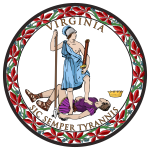| Elections in Virginia |
|---|
 |
Only ten of the nineteen Virginia incumbents were re-elected.
| District | Incumbent | Party | First elected | Result | Candidates |
|---|---|---|---|---|---|
| Virginia 1 | Robert Page | Federalist | 1799 | Incumbent retired. New member elected. Democratic-Republican gain. | √ John Smith (Democratic-Republican) 59.3% Phillip C. Pendleton (Federalist) 40.7% |
| Virginia 2 | David Holmes | Democratic-Republican | 1797 | Incumbent re-elected. | √ David Holmes [Note 1] (Democratic-Republican) Alexander Sinclair (Federalist) |
| Virginia 3 | George Jackson | Democratic-Republican | 1799 | Incumbent re-elected. | √ George Jackson [Note 1] (Democratic-Republican) Jonathan J. Jacobs (Federalist) Skidmore [Note 2] (Federalist) |
| Virginia 4 | Abram Trigg | Democratic-Republican | 1797 | Incumbent re-elected. | √ Abram Trigg [Note 1] (Democratic-Republican) |
| Virginia 5 | John J. Trigg | Democratic-Republican | 1797 | Incumbent re-elected. | √ John J. Trigg [Note 1] (Democratic-Republican) |
| Virginia 6 | Matthew Clay | Democratic-Republican | 1797 | Incumbent re-elected. | √ Matthew Clay [Note 1] (Democratic-Republican) |
| Virginia 7 | John Randolph | Democratic-Republican | 1799 | Incumbent re-elected. | √ John Randolph [Note 1] (Democratic-Republican) |
| Virginia 8 | Samuel Goode | Federalist | 1799 | Unknown if incumbent retired or lost re-election. New member elected. Democratic-Republican gain. | √ Thomas Claiborne [Note 1] (Democratic-Republican) |
| Virginia 9 | Joseph Eggleston | Democratic-Republican | 1798 (Special) | Unknown if incumbent retired or lost re-election. New member elected. Democratic-Republican hold. | √ William B. Giles [Note 1] (Democratic-Republican) |
| Virginia 10 | Edwin Gray | Democratic-Republican | 1799 | Incumbent re-elected. | √ Edwin Gray [Note 1] (Democratic-Republican) Nicholas Faulcon (Democratic-Republican) |
| Virginia 11 | Josiah Parker | Federalist | 1789 | Incumbent lost re-election. New member elected. Democratic-Republican gain. | √ Thomas Newton Jr. (Democratic-Republican) 93.6% John Niveson (Federalist) 5.7% Josiah Parker (Federalist) 0.7% |
| Virginia 12 | Thomas Evans | Federalist | 1797 | Incumbent retired. New member elected. Federalist hold. | √ John Stratton [Note 1] (Federalist) John Page (Democratic-Republican) |
| Virginia 13 | Littleton Waller Tazewell | Democratic-Republican | 1800 (Special) | Incumbent retired. New member elected. Democratic-Republican hold. | √ John Clopton [Note 1] (Democratic-Republican) Samuel Tyler (Democratic-Republican) |
| Virginia 14 | Samuel J. Cabell | Democratic-Republican | 1795 | Incumbent re-elected. | √ Samuel J. Cabell [Note 1] (Democratic-Republican) |
| Virginia 15 | John Dawson | Democratic-Republican | 1797 | Incumbent re-elected. | √ John Dawson [Note 1] (Democratic-Republican) |
| Virginia 16 | Anthony New | Democratic-Republican | 1793 | Incumbent re-elected. | √ Anthony New [Note 1] (Democratic-Republican) Carter Braxton James M. Garnett (Democratic-Republican) Tunstall Banks Andrew Monroe Richard Banks Archibald Petetrie |
| Virginia 17 | Leven Powell | Federalist | 1799 | Incumbent lost re-election. New member elected. Democratic-Republican gain. | √ Richard Brent [Note 1] (Democratic-Republican) Leven Powell (Federalist) Joseph Lane Samuel Clapham |
| Virginia 18 | John Nicholas | Democratic-Republican | 1793 | Incumbent retired. New member elected. Democratic-Republican hold. | √ Philip R. Thompson [Note 1] (Democratic-Republican) John Blackwell (Federalist) |
| Virginia 19 | Henry Lee | Federalist | 1799 | Incumbent retired. New member elected. Democratic-Republican gain. | √ John Taliaferro (Democratic-Republican) 63.0% John Taylor (Federalist) 37.0% |





